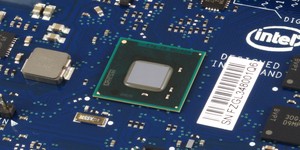
Intel is continuing its assault on the embedded computing market with the announcement of a new Quark processor variant, the Quark SE, small enough to be embedded into a coat button.
The follow-up to 2013's Quark launch, announced at the Intel Developer Forum as an ultra-low-power embedded processor based on the company's ageing Pentium microarchitecture, the Quark SE is considerably smaller than its already-diminutive predecessor. The result: an embedded computing module feature a Quark SE processor, Bluetooth Low Energy (LE) radio module and sensors including an accelerometer and gyroscope, small enough to be embedded into a coat button.
Unveiled during his Consumer Electronics Show (CES) keynote speech this week by Intel's Bryan Krzanich, the Curie module - following on from Galileo and Edison in Intel's science-themed embedded product naming convention - runs an open-source platform dubbed Viper, designed for wearable computing and built to track information from its on-board sensors. The result, Intel claims, is a module which can be used to build anything from an exercise monitor to a safety system without a great deal of in-house engineering work.
Intel appears to be positioning the Curie, which will launch in the second half of this year, as an intelligent accessory for smartphone, tablet and wearable devices based on its more powerful Atom processor family. 'In the future, we will see wearable products created by companies that have historically never used silicon before,' claimed Intel's Mike Bell at the unveiling. 'It’s now up to the ecosystem to innovate with this technology; rings, bags, bracelets, pendants and yes, buttons, will all be possible.'
The Curie module itself features a single-core 32-bit Quark SE system-on-chip (SoC) running at an undisclosed clockspeed likely significantly lower than the usual 400MHz, 384KB of flash program storage and 80KB of working static RAM (SRAM) alongside the Bluetooth LE radio, DSP sensor hub with pattern-recognition capabilities, accelerometer, gyroscope and battery charging circuitry. Power draw has not been disclosed, but Intel claims the module is capable of running 'for extended periods' from a coin-sized lithium battery.
More details are available on the official product page.
The follow-up to 2013's Quark launch, announced at the Intel Developer Forum as an ultra-low-power embedded processor based on the company's ageing Pentium microarchitecture, the Quark SE is considerably smaller than its already-diminutive predecessor. The result: an embedded computing module feature a Quark SE processor, Bluetooth Low Energy (LE) radio module and sensors including an accelerometer and gyroscope, small enough to be embedded into a coat button.
Unveiled during his Consumer Electronics Show (CES) keynote speech this week by Intel's Bryan Krzanich, the Curie module - following on from Galileo and Edison in Intel's science-themed embedded product naming convention - runs an open-source platform dubbed Viper, designed for wearable computing and built to track information from its on-board sensors. The result, Intel claims, is a module which can be used to build anything from an exercise monitor to a safety system without a great deal of in-house engineering work.
Intel appears to be positioning the Curie, which will launch in the second half of this year, as an intelligent accessory for smartphone, tablet and wearable devices based on its more powerful Atom processor family. 'In the future, we will see wearable products created by companies that have historically never used silicon before,' claimed Intel's Mike Bell at the unveiling. 'It’s now up to the ecosystem to innovate with this technology; rings, bags, bracelets, pendants and yes, buttons, will all be possible.'
The Curie module itself features a single-core 32-bit Quark SE system-on-chip (SoC) running at an undisclosed clockspeed likely significantly lower than the usual 400MHz, 384KB of flash program storage and 80KB of working static RAM (SRAM) alongside the Bluetooth LE radio, DSP sensor hub with pattern-recognition capabilities, accelerometer, gyroscope and battery charging circuitry. Power draw has not been disclosed, but Intel claims the module is capable of running 'for extended periods' from a coin-sized lithium battery.
More details are available on the official product page.

MSI MPG Velox 100R Chassis Review
October 14 2021 | 15:04








Want to comment? Please log in.